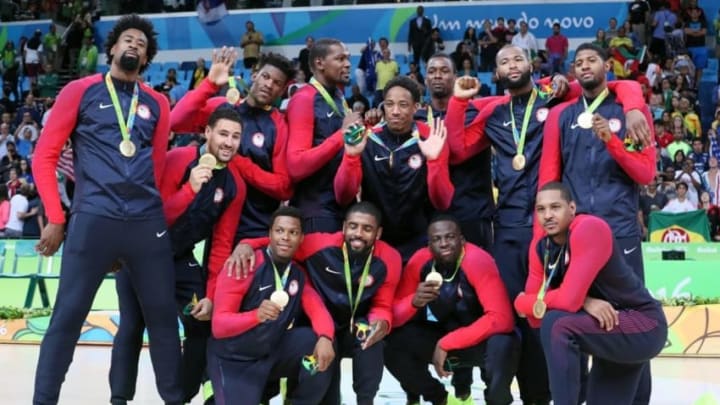As the 2016 Olympics iteration of Team USA – the Meme Team – completed its at times shaky but still ultimately overpowering run through international competition, there were few questions left to answer about the United States vs. the World. The only debates were about the United States vs. Itself. One of those popular debates about Team USA internally is how Olympic/International play affects the growth of the players selected. For the most part, older players are what they are, but it’s become popular to claim that a young player will start performing better in the NBA as a result of Team USA experience.
This year’s team contained several young players making their international debuts – Jimmy Butler, Harrison Barnes, Draymond Green, etc. How will being on Team USA affect them? Let’s look to history within the Coach K era to find out.
Since 2006, Team USA has seen 18 different international newcomers (players like LeBron James and Carmelo Anthony wouldn’t count under this parameter, since they first appeared in 2004, prior to Coach K). We can use Box Plus-Minus as an all encompassing metric for this purpose and look at how BPM changes for players from pre-international play to afterwards. Graphing the mean BPM for international players from two years prior to international debuts to two years after provides a solid starting point for discussion.

The growth rates certainly look promising on first glance. But when looking at Olympics play only, one thing stands out – the change in BPM from the season directly before the Olympics to the season directly afterwards actually shows the lowest year-over-year growth among that 4-year span. Plus, the Olympics curve is skewed by Anthony Davis, who had no NBA experience prior to the Olympics but was a budding superstar from the jump.
More from Nylon Calculus
- Nylon Calculus: Reviewing preseason predictions for the Western Conference
- Nylon Calculus: Reviewing preseason predictions for the Eastern Conference
- Nylon Calculus: LeBron James and the slam dunk aging curve
- The Whiteboard: Why has the NBA seen so many 50 point games this season?
- Nylon Calculus: 15 early season predictions for the NBA Western Conference
Now if we include the FIBA World Cup within our scope as well as the Olympics, the overall BPM is lower, which makes sense — the FIBA World Cup generally features players at a younger age, when they’re still just starting to tap their potential. Plus, the perception of the World Cup as a lesser prize than a gold medal perhaps has some effect on how many of the very top players choose to accept invitations.
Yet, one observation still remains. The year-over-year growth still slows down after the season directly before the Olympics. The biggest jump for those players, on average, comes from two years before the Olympics to the year before. This suggests then, that, it’s not Team USA that makes great players but rather that Team USA for the most part just identifies players who are already on a high-growth path and have broken out in the season before.
Since most players that play for Team USA will make their international debuts by their fifth season in their league (with some exceptions, i.e. Paul George, who was set back by his injury prior to the World Cup), we can also examine the growth curve of a larger sample of good-to-great players within their first five years in the league. As a baseline for determining which players to look at, I used the same players from my list of top 70 players that I’ve previously used for various other analyses, removing those who’d appeared in a Team USA uniform plus LeBron James, who was a massive outlier, not surprising given his status as the greatest player of this era.

Some players like Zach Randolph and Kyle Korver were late bloomers, racking up unimpressive BPMs through their first five seasons, while players like Blake Griffin and Kawhi Leonard showed evidence of their impending stardom from the start. Overall, the average growth is not substantially slower than for Team USA debutantes, and a nuanced look at the box plots for the players across seasons 1-5 reveals that the growth starts to typically taper off beginning in season four (with the caveat that there’s a lot of variability in the highest and lowest quartiles…the mean, however, aligns pretty well with the median). The average BPM curve here actually looks very similar to the growth curve for young players relative to their first Team USA experience.
So what does this mean for players like Harrison Barnes? For one, it would be foolish to expect a drastic jump just because he was with Team USA. The myth of accelerated growth for young players from international play is just that – a myth. Their development doesn’t appear to be substantially different from that of other good players in their first few seasons.
It would be more reasonable to say that we perceive the accelerated growth from a selection bias. Team USA generally selects players who are already on a high growth curve and have started to break out. Players like Harrison Barnes, who are perfectly serviceable but who have shown no aptitude for stardom, will not simply explode just as a result of being on Team USA. He is the exception, not the rule. Like Mason Plumlee and Kenneth Faried before him, he is what he is. Faried never actually capitalized on his “breakout” FIBA World Cup play, and he was a key contributor on his international team. Barnes was a benchwarmer. Other first-time players like Paul George and Jimmy Butler are already established studs. There’s a very good chance that they’ll play at a high level next season. But it won’t be due to their turn at Rio. It’ll be because that’s what stars are expected to do.
More from NC: Differences in offensive vs defensive analytics
